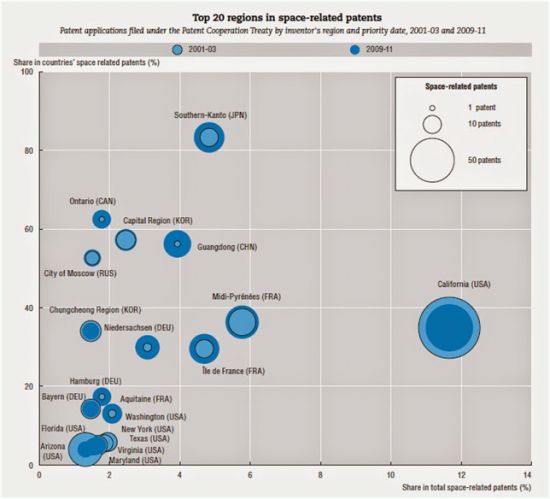The global space-patent economy is growing by leaps and bounds with respect to export and import volumes in the recent years. According to the Twelfth Five Year Plan (2012-2017), India is also contributing to the space race by assigning USD 7.4 billion1 towards this. The major patentable space related inventions include general satellite technologies, Satellite navigation, Cosmonautics, Satellite communications, Satellite earth observation.2 Now, outer space and patent rights are subject to two different schools of jurisprudence, and their regimes do not go hand in hand.
- The patent regime advocates monopolistic rights for the person exploiting the intellectual creations. Thus inventor would be entitled to reap the benefits of his or her invention by getting exclusive rights over the use of others, in terms of royalty.
- Whereas 'space law' on the other hand has some fundamental principles like the "province of all mankind," "common heritage of mankind," "benefit of all countries," amongst others, which stand up for common benefits.

In terms of space related patenting on a regional scale, the highest shares can be found in regions of USA with highest around 12%, France 10%, Japan 5% and China 4% between the years 2001-03 and 2009-11.3 When other countries are way ahead in the space patents race, India is lagging in the race having a nominal fraction of 0.6% of PCT applications between years 2000-2003 and 2009-11.4

The Indian Space programme has been active for more than half-a-century and the Indian Space Research Organization (ISRO) is the main manufacturer of space products in India. It assembles satellites, and launches space vehicles from over eleven centers boasting of more than 14000 employees.
Since 1973, ISRO has filed several applications before the Indian Patent Office, of which about 270 have been granted till 2014.5

On the contrary, only 45 Copyrights and 10 Trade Marks have been granted by the IPO. So it is evident that space patents would take pivotal role in the growth of Indian economy and thus needs to be addressed with measures. As of this date India does not feature in the list of top 20 regions in space related patents list on a global scale.6

In the recent sectorial policy Space Sector is allowed to have upto 74% Foreign Direct Invest Investment through government route. Again, private entities are expected to become more important as the demand for PSLVs currently surpasses ISRO's production capacity. Thereby the need of telecommunication satellites is constantly increasing, as there already is extensive use of telemedicine, tele-education in rural areas. About 7957.61 million people use telephones as of 30th September 2014,7 and 56.5 million subscribers are registered with 6 private direct-to-home (DTH) services as of 31st March 2013 in India.8 It is expected that private entities will play a major role in the space sector. If any private entity invents any space product, then question arises as to who will be the true holder of patent rights. The focus lies with Patent rights, as it already enjoys a strong position in the IP Portfolio of ISRO. It is safe to assume that investors will favor space related inventions.
Now, if we assume that intellectual creations in outer space can be subject to the patent regime, related questions for consideration are:-
- Who has the right to patent protection? Will it be the 'first to file' or the 'first inventor to file'?
- Ownership rights of private investors
- As outer space does not belong to any one State, the complex question of jurisdiction and applicable law comes into the fore in every case of infringement of the Earthly patents.
- How to treat inventions pertaining to the defense utilities and under the protection of secrecy?
Again, there is no legal provision which answers the above mentioned question in India and to attract investors to invest in the space patent sector for the harmonious growth. There is no concrete legal regime in India to meet the questions raised here.
Thus, we need to have a comprehensive space patents legislation which shall in turn create the right balance between international obligations pertaining to space law and monopolistic patent rights. This would in turn help in establishing national security, growth and sovereignty in the technology driven space economy in India.
Footnotes
1. The Space Economy at Glance 2014, available at: http://www.oecd-ilibrary.org/docserver/download/9214061e.pdf?expires=1423394326&id=id&accname=guest&checksum=A6453B005F605213B25A7F83C941B9E7 , last visited on 08 February 2014.
2. Ibid
3. Ibid
4. Ibid
5. Patent-ISRO, available at: http://www.isro.gov.in/isro-technology-transfer/patent , last visited on 08 February 2015.
6. Supra, n.01
7. Highlights of Telecom Subscription Data as on 30th September 2014, available at http://www.trai.gov.in/WriteReadData/WhatsNew/Documents/PR-TSD-Sep-14.pdf , last visited on February 8, 2015.
8. The Indian Telecom Services Performance Indicators January-March 2013, available at http://www.trai.gov.in/WriteReadData/WhatsNew/Documents/Indicator%20Reports%20-01082013.pdf , last visited on 08 February 2014.
The content of this article is intended to provide a general guide to the subject matter. Specialist advice should be sought about your specific circumstances.

